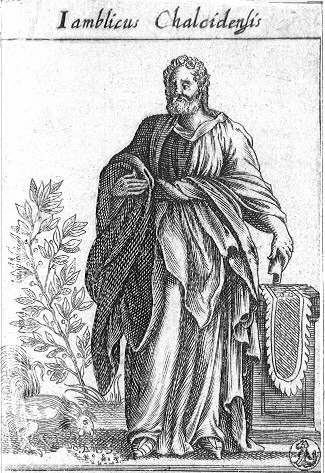”Living Theurgy” is a fascinating but extremely difficult book authored by Jeffrey S Kupperman, a member of the so-called Apostolic Johannite Church, a “Gnostic” group based in the United States. The book deals with Neo-Platonism, but is unusual in the sense that Kupperman, although a scholar, claims that Neo-Platonist theory and practice form a viable spiritual path. Since many Neo-Platonist writings are lost, Kupperman attempts to reconstruct the path by using widely divergent sources and his own creative imagination. Thus, this is not a scholarly book but rather a kind of Neo-Platonist re-imagining for advanced seekers.
Kupperman's interpretation of Neo-Platonism is centered on Iamblichus, but also
draws inspiration from Proclus, Julian the Philosopher (otherwise better known
as Julian the Apostate, the last pagan emperor of Rome), the so-called Greek
Magical Papyri (PGM), Pseudo-Dionysius and Marsilio Ficino. Kupperman sounds
“pagan”, but believes that Neo-Platonism can be combined with Christianity,
Judaism and Islam. He doesn't sound particularly Gnostic in the ancient sense
of that term, rejecting notions such as strict dualism or an evil Demiurge.
As indicated by the title, “Living Theurgy” is a book about the much-maligned
Neo-Platonist practice of theurgy, often seen as a form of ritual magic. To the
author, theurgy is rather a path to divinization. Its highest form entails the
calling forth of the theurgist's personal daimon or guardian angel. Other forms
include possession, the animation of sacred statues and talismanic magic. A
large part of “Living Theurgy” consists of descriptions of elaborate rituals,
including long prayers and hymns. Many of the rituals are “freely based” on
ancient sources. It seems that the original theurgic rituals have been
irretrievably lost. The material on talismans is taken from Ficino's writings.
Kupperman emphasizes that theurgy is impossible without prior philosophy and
“theology”. The soul is purified through philosophical insights and religious
worship. Even political activity on behalf of the community can be a form of
prior purification. (Here, Kupperman takes a cue from the extremely interesting
study “Platonopolis” by Dominic J O'Meara.) Thus, while theurgy is in a sense
an esoteric practice, the exoteric practices are equally necessary, not in
order to dissimulate in front of the dumb multitude, but as preliminary
spiritual steps towards the esoteric goal.
Although “Living Theurgy” is primarily about ritual worship and magic, the
chapters on the philosophical and theological aspects of Neo-Platonism are just
as extensive. The author deals with such issues as the problem of evil,
incarnation and reincarnation, the relationship between Fate and Providence
(hint: they are the same), the different kinds of gods and daimons (described
in surprising detail), and microcosm/macrocosm. The philosophy chapter also
includes meditation exercises. Kupperman admits that the Neo-Platonist sages
didn't always agree, and when they don't, tends to side with Iamblichus. It's
interesting to note that Iamblichus was more positive towards matter than other
Platonists, and that he seldom attacked Christianity. Otherwise, I get the
impression that the author is enamored with Ficino, to the point of treating
his talismanic-astrological magic as a form of theurgy, while admitting that
this isn't the standard view (since Ficino attempts to “pull down” divine
energies rather than “raise up” his own soul).
As already indicated, this is not a book for the general reader, and I admit
that I only skimmed some sections. Here is an example of how Kupperman can
sound like: “The Paradigm is also Aion, lion-headed Eternity, the vertical
extension of the One-Being in the noetic realm. This association places the
Father of Demiurges at the summit of the noetic realm, as an intelligible
aspect of the One, hence the first Demiurge’s pre-essential nature. In this
respect, Proclus’ interpretation of Aion encompassing the whole of the noetic
realm has some merit. Aion is the three noetic moments existing at the noetic,
noetic-noeric, and noeric levels, as well as the encompassing monad and henad,
the unifying divinity, of the noetic realm.” (Kindle Locations 2771-2777). This
is actually a relatively easy passage!
Personally, I nevertheless found the work intriguing, and even “meditated”
(well, sort of) on some of its ideas, including Fate-Providence. For that
reason, I give it four stars. If the Philosophia, Theologia and Theourgia (or
Synthemata and Symbola) contained herein will, fatefully or otherwise, bring us
closer to God, is, alas, not a question I can answer at the present time…

No comments:
Post a Comment